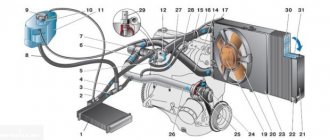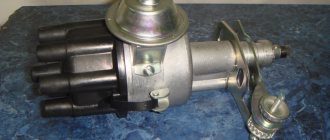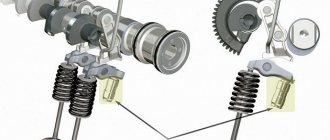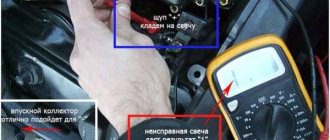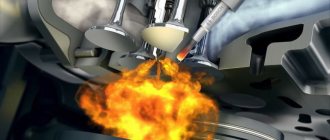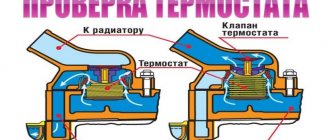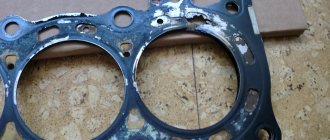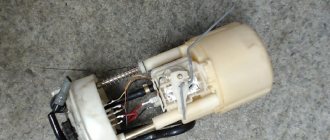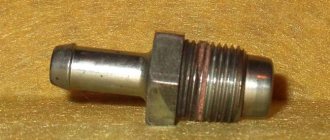Hi all! The topic of our conversation today will be the answer to the question of how to check the expansion tank cap with your own hands. Although some people do this with their mouth, I still do not recommend experimenting with your own health. There are much simpler and safer ways.
As you know, the expansion tank serves to store coolant. Just not to be confused with the anti-freeze tank, which is used as part of the windshield washer system. Without antifreeze or coolant (coolant), your internal combustion engine will not last long.
It is on this tank that there is a special lid. It would be more correct to call it a valve cover. The device seems simple, but in fact the lid bears a lot of responsibility.
Cover tasks
The serviceability of the valve cover from the expansion tank directly affects the performance of the entire cooling system of the power unit.
During operation, the engine heats up, which is quite natural and understandable to everyone. When the engine heats up, antifreeze takes away some of this heat so that the internal combustion engine does not overheat. When the coolant itself heats up, it increases in volume, that is, it expands, and at the same time the internal pressure in the system increases. The hotter the engine, the higher the pressure in the cooling system. In order to avoid ruptures of the pipes and the tank itself, the radiator and other components through which antifreeze or antifreeze passes, a valve cover is used.
It is very important not only to tighten the plug correctly, but also to periodically check its functionality. If repairs or replacements are required, they are carried out at the first sign of problems.
The lid serves not only as protection against overpressure. The design provides two valves, or one, but combining both functions. One valve serves to relieve excess pressure, and the other to inject it.
For the motor to work correctly, it must be maintained at operating temperature. Typically it is in the range from 95 to 120 degrees. Depends on the design features of the engine itself. At these temperatures, the expansion of the coolant occurs by approximately 20-30%. This leads to excess pressure. And normal pressure is considered to be 1.1-1.5 atmospheres. The valve cap of the expansion tank, if necessary, removes excess pressure from the system, or pumps it in so that a vacuum does not form inside, the pipes do not compress and the hoses do not stop circulating antifreeze.
If the plug is working correctly, the engine will operate at optimal temperature and normal operating pressure. If not, the consequences of a malfunction can be disastrous for the internal combustion engine. And the culprit is the usual lid.
Signs of a faulty expansion tank cap
Unfortunately, some sellers offer car owners low-quality products, including plugs that can allow the pressure in the engine cooling system to increase to 1.3–1.5 atm or more, which significantly exceeds normal values.
Let's talk about several types of plugs designed for front-wheel drive Lada. Expansion tank caps for this car are produced by many manufacturers. Moreover, regardless of the difference in the color of the body, thread, “filling,” or the presence of inscriptions, the valves of the product must open when the pressure in the system reaches 1.1 atm.
If the plug is made poorly, then you may encounter a situation where excess pressure is released for an unnecessarily long time. Or, for example, the valve opens when the pressure reaches half the value, i.e. when it increases to 0.5-0.6 atm.
We recommend
“Liquid glass for a car: effective protection and attractive appearance” Read more
Malfunctions of the expansion tank cap are most often the cause of boiling of the coolant - owners of VAZ cars often encounter similar consequences. If the engine temperature is within the operating range, then it is obvious that the plug is not able to maintain the required pressure inside the cooling system.
A similar malfunction can be caused by another reason - a malfunction of the vacuum valve has led to air entering the car’s engine cooling system and the formation of an air lock, preventing normal circulation and, accordingly, cooling of the liquid. In the cold season, an air lock can lead to poor performance of the car's heater. In addition, you will have to constantly add coolant, since the increased pressure will drive it out through the joints between the fittings and the pipes put on them, as well as through the clamps.
The negative consequences of poor performance of the expansion tank cap are:
- rupture of low-quality or worn-out pipes (not only owners of VAZ cars may encounter such a problem);
- leaks in the main or heating radiator;
- thermostat housing rupture;
- expansion tank rupture.
To prevent these consequences, it is worth familiarizing yourself with the signs indicating unsatisfactory operation of the expansion tank cap valve. We list the main ones:
- The appearance of smoke from the engine compartment is most often caused by coolant leaking out of the expansion tank and hitting the intake manifold, which is heated to a high temperature . The positive point in this situation is the normal temperature of the engine itself. This sign indicates a failure of the plug valve. A normally functioning valve releases pressure from the system when it reaches a certain value, but in some cases the release begins ahead of time, which leads to antifreeze or antifreeze splashing out of the expansion tank.
- Despite the engine overheating, the heater pumps cold air into the cabin . This situation is possible if the valve that controls low pressure in the engine cooling system breaks down. When it fails, air enters the system and air pockets occur, causing the power unit to overheat.
- The appearance of traces of coolant in the area of clamps, pipes or under the radiator indicates valve failure . Excess pressure from the system is not released, leading to the breakdown of clamps, rupture of tubes and damage to the radiator.
At the same time, it is not always possible to limit yourself to replacing only the expansion tank cap; in some cases, you will also need a new radiator, clamps, tubes, and seals. Sometimes too high pressure causes the expansion tank itself to rupture. In this case, you will have to change the entire system assembly.
Cover device
It is important to understand that there is a locking element for expansion tanks on any car that has an internal combustion engine under the hood. And it doesn’t matter whether it’s diesel, gasoline or gas-powered.
Therefore, the problem with the failure of this unit can occur on any car, including such models as:
How to properly light a car from another: a reminder for the car enthusiast
- Lada Kalina;
- Ford Focus;
- Gazelle Next;
- Daewoo Lanos;
- Volkswagen Passat;
- Lada Priora;
- VAZ 2110;
- Renault Logan;
- Opel Astra;
- VAZ 2114;
- Chevrolet Lacetti, etc.
You already understand that the cap serves not only to prevent coolant from pouring out of the tank. This is also a pressure regulator in the system.
A valve is hidden inside the lid, usually made of plastic. It is he who takes on such responsibility. The valve is immersed inside the expansion tank and, as necessary, pumps or releases excess pressure.
Before buying a new element, if you suspect the old one is broken, you can check it. A similar type of locking mechanism should be selected.
Please note that all modern foreign cars, in the vast majority of cases, have switched to single-valve caps for expansion tanks. That is, only one valve design is physically present. It just can perform two functions at once. While on domestic cars you can still find a pair of valves. Each of them is responsible for performing a corresponding function. Whether this is good or bad is difficult to judge. But the fact remains a fact.
The lid is activated only when an excess or deficit of pressure is detected in the system. Each car has its own temperature and pressure standards for the element to operate.
What types of lids are there?
It is practical to use covers designed for the OS of a specific car model. If you install a non-standard modification (if it fits the thread), it may not release excessive pressure in time or may not release excessive pressure at all.
